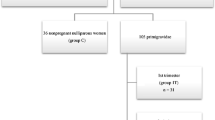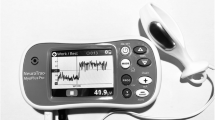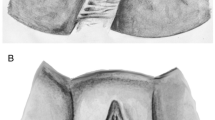Abstract
The aims of this study were to analyse the effect of different body positions on pelvic floor muscle (PFM) assessment using digital muscle testing, manometry and transabdominal ultrasound. In addition, subject acceptance of each testing position was recorded. Subjects were 20 women's health physiotherapists. The testing protocol included the best of three maximum voluntary contractions tested in each of four positions (crook lying, supine, sitting and standing). Significant differences in muscle strength and subject acceptance between positions were found with each tool, most often between lying and upright positions. Digital muscle testing and vaginal squeeze-pressure scores were highest in the lying position, and vaginal resting pressure and transabdominal ultrasound scores were highest in the standing position. Subjects preferred the lying positions for internal examinations. The clinical significance of these differences and the reasons for these variations require further investigation.



Similar content being viewed by others
References
Bø K, Sherburn M (2005) Evaluation of female pelvic floor muscle function and strength. Phys Ther 85:269–282
Messelink EJ, Benson JT, Berghmans LCM, Bø K, Corcos J, Fowler CJ, Laycock J, Lim Huat Chye P, van Lunsen HW, Lycklama a Nijeholt AAB, Pemberton JH, Wang A, Watier A (2003) Terminology of pelvic floor function and dysfunction, v3, draft report. ICS Pelvic Floor Clinical Assessment Group, Bristol
Bump RC, Mattiasson A, Bø K, Brubaker LP, DeLancey JO, Klarskov P, Shull BL, Smith AR (1996) The standardization of terminology of female pelvic organ prolapse and pelvic floor dysfunction. Am J Obstet Gynecol 175(1):10–17
Frawley HC, Galea MP, Phillips BA, Sherburn M, Bø K (2005) Reliability of pelvic floor muscle strength assessment using different test positions and tools. Neurourol Urodyn (in press)
Bø K, Finckenhagen HB (2003) Is there any difference in measurement of pelvic floor muscle strength in supine and standing position? Acta Obstet Gynecol Scand 82(12):1120–1124
Sherburn M, Murphy CA, Carroll S, Allen TJ, Galea MP (2005) Investigation of transabdominal real-time ultrasound to visualise the muscles of the pelvic floor. Aust J Physiother 51(3):167–170
Aukee P, Immonen P, Penttinen J, Laippala P, Airaksinen O (2002) Increase in pelvic floor muscle activity after 12 weeks' training: a randomized prospective pilot study. Urology 60(6):1020–1023; discussion 1023–1024
Aukee P, Penttinen J, Airaksinen O (2003) The effect of aging on the electromyographic activity of pelvic floor muscles: a comparative study among stress incontinent patients and asymptomatic women. Maturitas 44(4):253–257
Parkkinen A, Karjalainen E, Vartiainen M, Penttinen J (2004) Physiotherapy for female stress urinary incontinence: individual therapy at the outpatient clinic versus home-based pelvic floor training: a 5-year follow-up study. Neurourol Urodyn 23(7):643–648
Bø K, Raastad R, Finckenhagen HB (2005) Does the size of the vaginal probe affect measurement of pelvic floor muscle strength? Acta Obstet Gynecol Scand 84(2):129–133
Bø K, Finckenhagen HB (2001) Vaginal palpation of pelvic floor muscle strength: inter-test reproducibility and comparison between palpation and vaginal squeeze pressure. Acta Obstet Gynecol Scand 80(10):883–887
Bø K, Kvarstein B, Hagen RR, Larsen S (1990) Pelvic floor muscle exercise for the treatment of female stress urinary-incontinence: II. Validity of vaginal pressure measurements of pelvic floor muscle strength and the necessity of supplementary methods for control of correct contraction. Neurourol Urodyn 9(5):479–487
Laycock J (1994) Clinical evaluation of the pelvic floor. In: B Schussler, J Laycock, P Norton, S Stanton (eds) Pelvic floor re-education. Springer, Berlin Heidelberg New York, pp 42–48
Sapsford RR, Hodges PW (2001) Contraction of the pelvic floor muscles during abdominal maneuvers. Arch Phys Med Rehabil 82(8):1081–1088
Dietz HP, Clarke B (2001) The influence of posture on perineal ultrasound imaging parameters. Int Urogynecol J Pelvic Floor Dysfunct 12(2):104–106
Peschers UM, Gingelmaier A, Jundt K, Leib B, Dimpfl T (2001) Evaluation of pelvic floor muscle strength using four different techniques. Int Urogynecol J Pelvic Floor Dysfunct 12(1):27–30
Mouritsen L, Sander P, Bernstein I, Bach A (1999) Comparison of palpation, ultrasonography and perineometry for examination of the pelvic floor (abstract). Int Urogynecol J Pelvic Floor Dysfunct 10(Suppl 1):S16–S17
Dietz HP, Clarke B, Wilson PD (1998) A new method for quantifying levator activity and teaching pelvic floor muscle exercises. Neurourol Neurodyn 17(4):436–437
Constantinou CE, Hvistendahl G, Ryhammer A, Nagel LL, Djurhuus JC (2002) Determining the displacement of the pelvic floor and pelvic organs during voluntary contractions using magnetic resonance imaging in younger and older women. BJU Int 90(4):408–414
Author information
Authors and Affiliations
Corresponding author
Rights and permissions
About this article
Cite this article
Frawley, H.C., Galea, M.P., Phillips, B.A. et al. Effect of test position on pelvic floor muscle assessment. Int Urogynecol J 17, 365–371 (2006). https://doi.org/10.1007/s00192-005-0016-3
Received:
Accepted:
Published:
Issue Date:
DOI: https://doi.org/10.1007/s00192-005-0016-3




